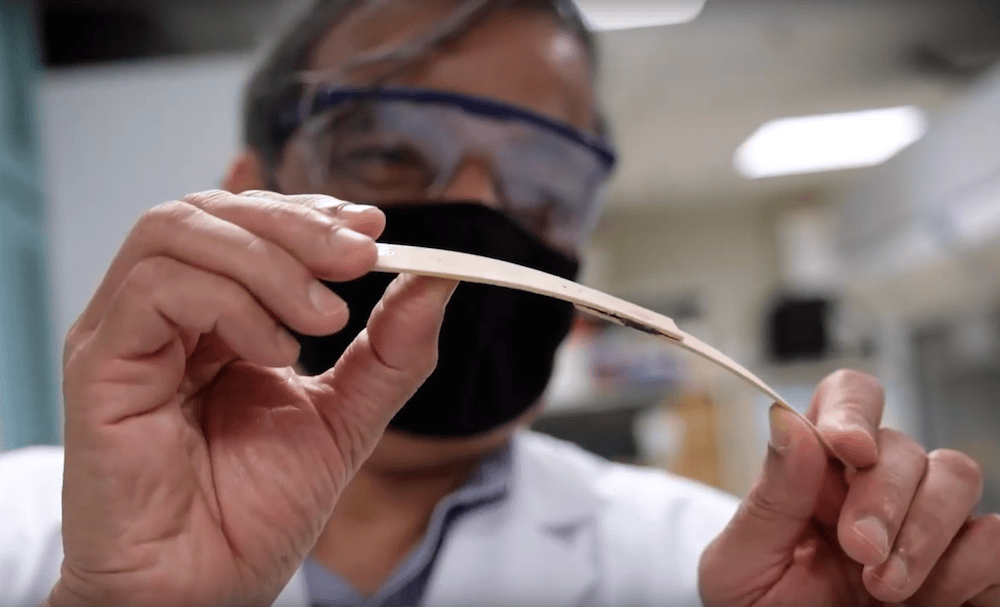
[Image above] A Nanyang Technological University researcher shows off two pieces of wood glued together using a new magnetocuring adhesion process. Credit: NTUsg, YouTube
While there is work being done to combine disparate materials directly, by and large industry still relies heavily on adhesives to perform this task.
Adhesives are nonmetallic substances—most often polymers or resins—that bind two materials together by adhering to the surface of each. Compared to other binding techniques such as sewing, mechanical fastenings, and welding, adhesives offer certain advantages including cost-effectiveness and more efficient distribution of stress across a joint.
Conventional adhesives like epoxy typically “cure,” i.e., reach their final hardness and strength, using moisture, heat, or light. However, these curing methods can come with limitations, such as the need for specific substrates or energy-intensive environmental conditions.
In the case of carbon fiber, use of large, high-temperature ovens to cure the epoxy glue over many hours is a major factor in the fiber’s high cost. So developing alternative curing methods may help lower the cost of carbon fiber manufacturing.
Magnetocuring is an emerging method for curing heat-activated adhesives. It uses alternating magnetic fields rather than a conventional furnace to generate heat for the curing process. Specifically, heat is generated by nanoparticles embedded in the adhesive that warm when exposed to electromagnetic energy.
Researchers have conducted several magnetocuring studies using various nanoparticles as additives, including iron cobalt epoxy composites and nickel particles in thiol-acrylate and thiol-ene composite systems. Unfortunately, these formulations were never successfully commercialized because
- Absence of surface functionalization led to poor colloidal stability of the magnetic nanoparticles, and
- Nanoparticle aggregates led to thermal hotspots and localized resin/epoxy pyrolysis.
Surface functionalized magnetic nanoparticles may overcome these limitations. Not only would the surface functionalization improve colloidal stability, “The bonding initiation can be precisely tuned to the Curie nanoparticle cutoff temperature with optimized heating, allowing bonding to heat-sensitive substrates while eliminating scorching,” researchers write in a recent paper.
The researchers come from Nanyang Technological University (NTU) in Singapore, and they explored using oxide nanoparticles consisting of manganese, zinc, and iron (MnxZn1-xFe2O4) as additives in the magnetocuring process.
They functionalized the nanoparticles’ surface by coating with oleic acid (to prevent agglomeration) and bisphenol A diglycidyl ether (to help interface with the adhesive upon thermoset initiation). They then added the nanoparticles to a commercially available epoxy and performed multiple tests to determine the efficiency of magnetocuring adhesion.
Their tests confirmed long-term colloidal stability of the nanoparticles and successful prevention of overheating, which were the two issues that previous studies faced. In particular, the formulation Mn0.7Zn0.3Fe2O4 offered the best results.

Credit: NTUsg, YouTube
In the NTU press release, NTU professor Raju Ramanujan predicts their technology may increase the efficiency of manufacturing products that require adhesive joints.
“Our temperature-controlled magnetic nanoparticles are designed to be mixed with existing one-pot adhesive formulations, so many of the epoxy-based adhesives on the market could be converted into magnetic field-activated glue,” he says. In addition, “The speed and temperature of curing can be adjusted, so manufacturers of existing products could redesign or improve their existing manufacturing methods.”
The researchers acknowledge their approach has a few limitations, such as the fact it can only be used on nonmetallic substrates. However, they plan to conduct further studies to address these limitations, and they have filed a patent for the technology through NTU’s innovation and enterprise company.
The paper, published in Applied Materials Today, is “Magnetocuring of temperature failsafe epoxy adhesives” (DOI: 10.1016/j.apmt.2020.100824).
Author
Lisa McDonald
CTT Categories
- Manufacturing
- Material Innovations


